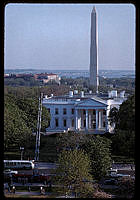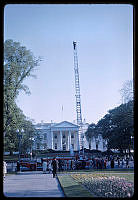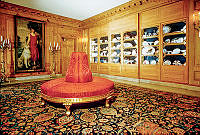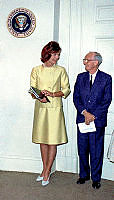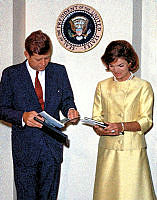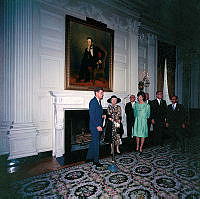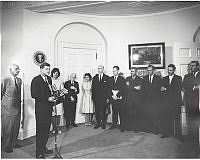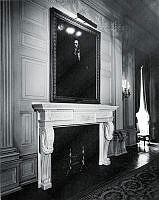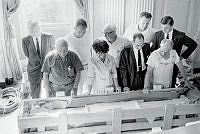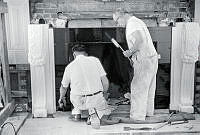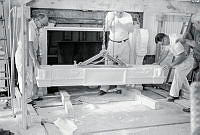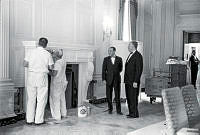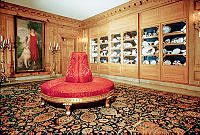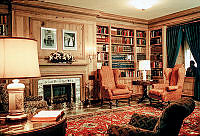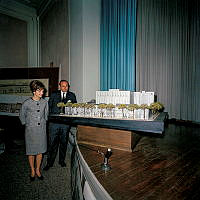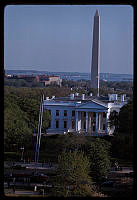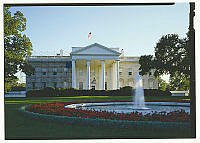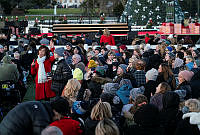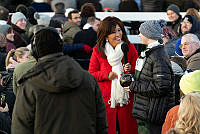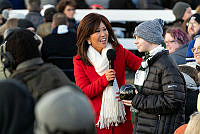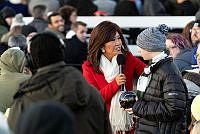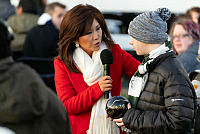The Solarium
A Room of Their Own
Copyright © June 01, 2011 White House Historical Association. All rights reserved under international copyright conventions. No part of this article may be reproduced or utilized in any form or by any means, electronic or mechanical, including photocopying, recording, or by any information storage and retrieval system, without permission in writing from the publisher. Requests for reprint permissions should be addressed to books@whha.org

President Lyndon B. Johnson’s daughters found the Solarium to be a private retreat where they could study and spend time with friends. The room is seen here set for a buffet prior to the wedding of Luci Johnson to Pat Nugent in 1966. Friends painted Luci’s signature smiley face on the window.
Library of Congress, Look Magazine Photograph CollectionThe Solarium on the Third Floor has been called the “The Camp David of the White House.”1 With its floor-to-ceiling windows and its panoramic view of the Washington Monument and the Mall, the Solarium has been from its inception the retreat of first families. Here they find a cozy place where they can escape from their public roles and enjoy the pleasures of ordinary family life. Here, too, they hold private meetings with staff, cabinet members, and in some cases heads of government. Over the years, the Solarium has served many purposes, but first and foremost it has given first families a room of their own.

The Solarium soon after its creation in 1927. First Lady Grace Coolidge called it her "Sky Parlor."
White House CollectionThe idea of a White House Solarium dates to the early twentieth century when President William Howard Taft added a rough-built sleeping porch to the roof of the White House so his family would have a cool place to pass Washington’s steamy summer nights. The permanent Solarium, however, was built as part of the addition in 1927 of a Third Floor to the Executive Mansion, during the administration of Calvin Coolidge.2

The sleeping porch prior to construction of the Solarium and the full Third Floor, 1920. It was built by President Taft in 1910.
Library of CongressOriginally a square room atop the South Portico, the Solarium was the brainchild of First Lady Grace Coolidge. She called it her “Sky Parlor”—an old Virginia term for a sunny attic room. People in the 1920s believed that sunlight and fresh air were vital to good mental and physical health, so sunrooms had become a popular feature in private homes.3 Ironically, health would be an issue seventy years later when President Ronald Reagan found the Solarium a therapeutic place in which to recover from an assassin’s bullet. Later he would tell another president, Bill Clinton, that the Solarium was his favorite room in the White House.4
From the beginning, the Solarium was the private domain of the first family. Mrs. Coolidge wrote, “It was understood that when there I was not to be disturbed, unless for some urgent reason.” She furnished the “greenhouse” type sunroom with “a cot bed, a writing table, some porch furniture, a phonograph and a portable radio,” which provided “comfort and entertainment.”5
Early in its history, the Solarium became identified with children, often the grandchildren of the presidents. The Franklin Roosevelts, for example, used the Solarium as a playroom and nursery for their grandchildren when they visited the White House. In her syndicated column, “My Day,” First Lady Eleanor Roosevelt described going up to the “sun parlor” to “see the babies in their carriages and the older ones sitting at the table with their nurses, each one trying to show how proficient they are in table manners.”6 Her oldest grandson, Curtis “Buzz” Dall, who with his sister, Anna Eleanor “Sistie” Dall, lived in the White House during Roosevelt’s first term, remembered occasional lunches with their grandfather in the Solarium. Roosevelt, whom the children called “Papa,” would “arrive on the elevator just ahead of the food trolley,” Curtis wrote. “He would be wheeled onto the third floor and then up the ramp outside the room—installed to accommodate his wheelchair—to the table.” Curtis remembered these lunches as raucous affairs where he and his sister “could be silly” and “rattle on as we wished.”7

The original Solarium during the Truman administration before Truman replaced it, 1948.
White House CollectionLater, during World War II, the mood in the Solarium became more somber. The Roosevelt children and grandchildren made fewer visits to the White House. In those years, Roosevelt, on his doctor’s orders, lunched in the Solarium rather than at his desk in order to take a break from the rigors of World War II.8
The Eisenhowers revived the Roosevelts’ practice of using the Solarium as a playroom and dining area for their grandchildren. By the 1950s the furnishings included a small black-and-white television set where David Eisenhower and his sisters, Barbara and Susan,9 could watch such popular children’s programs as Lassie, Howdy Doody, and The Mickey Mouse Club. The Solarium also housed a canary named Gabby and two parakeets, High Glory and Pete. But the Solarium’s real draw was the cache of new toys, selected from hundreds sent each month to the White House as gifts.10

Caroline Kennedy’s kindergarten classroom was set in the Solarium, 1963.
John F. Kennedy Presidential Library and Museum/NARALady Jacqueline Kennedy established there for their daughter, Caroline. Mrs. Kennedy designed the room, and the White House carpenters built it. When finished, the Solarium schoolroom had bookshelves, a sandbox, space for the class pets—rabbits, guinea pigs, goldfish—and plants.11 Up to twenty students attended the school, and all the parents including the Kennedys shared the cost of the teacher’s salary. Although the school complied academically with District of Columbia regulations, the Solarium nursery school was no ordinary educational institution. Very few children at any school can watch the red-carpet arrivals of state guests on the South Lawn of the White House or receive a reprimand for shouting “Boom! Boom!” in time with the twenty-one gun salute to honor a distinguished visitor. Few have a father whose arrival home is signaled by the sound of a helicopter and a classmate crying out, “your daddy’s home!” Practically none have access to their schoolrooms at night, but Caroline Kennedy did, accompanied by her mother. The two would often go up to the Solarium after hours to play in the sandbox.12
Older children also found the Solarium inviting— so inviting that in the words of a later first lady, Betty Ford, “A President’s children seem to head there as if directed by radar.” The Solarium’s location away from the Second Floor living quarters made it a natural getaway for young people and their friends not only from their parents but also from the constant surveillance that follows a president’s children and grandchildren in public. Bess Abell, the White House social secretary during the Johnson administration, later commented that the Solarium provided “the only way to get away from the Secret Service agents” for the Johnsons’ daughters, Lynda and Luci.13

President and Mrs. Gerald R. Ford and daughter Susan visit with Liberty and her first litter of puppies in the Solarium, 1975.
Gerald R. Ford Presidential LibraryThus the sun parlor became a “rec room.” Using the Solarium this way reflected the change in domestic living habits that occurred after World War II. As millions of Americans embraced suburban living, rec rooms and family rooms became standard features of their homes. The Trumans followed suit. As part of the comprehensive White House renovation in the early 1950s, the Solarium was enlarged and its shape changed from a square to an octagon. From outside, perched atop the South Portico yet tucked behind the old stone balustrade, it looked like a diner of the time. After furnishing the room with bright floral chintzes, pale rattan furniture, a ping-pong table, and a marbled linoleum floor, the Trumans used the Solarium for informal family meals, card parties, and other private gatherings.14 It was not until the Johnson administration, however, a decade later, that the Solarium came into its own as a rec room. The Johnsons turned the room into a bona fide teen hangout complete with soda fountain, bar stools, record players, a television set, and comfortable furniture. As a final finishing touch Luci, the Johnsons’ younger daughter, asked that the glass-paned door be replaced with a wooden door to prevent “servants and everybody looking in here to see what’s going on.”15

The Solarium is reconstructed during the Truman renovation, 1951.
White House CollectionA surprise party for Luci’s high school graduation caused a small commotion in the White House. While President Lyndon B. Johnson entertained former President Dwight Eisenhower and fifty other guests in the State Dining Room, forty of Luci’s friends were quietly making their way up to the Solarium. Luci, her hair in rollers and wearing shorts and an oversize shirt, was on the Second Floor with another group of friends relaxing. Because she thought she was going to Camp David, she had decided not to change her clothes. No one including Mrs. Johnson could convince her to change. Finally one of her friends told her someone was upstairs waiting to see her. Luci then changed her clothes, combed her hair, and went to the Solarium.16

The Solarium is refurnished following the renovation, 1951.
White House CollectionWith or without teenagers, the Solarium has often been the hub of private life in the White House. First Lady Mamie Eisenhower held card parties in the Solarium for her friends, while President Eisenhower enjoyed grilling steaks on the outside terrace. The Carters liked to watch televised football games there on Saturdays, with their children. First Lady Rosalynn Carter and her daughter-in-law Annette took Spanish lessons there, and the whole family liked stargazing using son Jeff’s telescope on the adjacent roof terrace. On the weekends when they did not go to Camp David, the Reagans had lunch in the Solarium and spent the afternoon there. The Clintons used the room to relax with friends over meals and games of cards, Boggle, or Upwords, a three-dimensional Scrabble game.17

President Dwight D. Eisenhower set up his portable grill in the area on the balcony outside of the Solarium. Note the heavy stone balustrade that bands the Solarium, 1959.
Dwight D. Eisenhower Presidential Library and Museum/NARANot all the events in the Solarium have been as private or as happy. Occasionally the Solarium has served as the site of historic and sometimes poignant events. First Lady Nancy Reagan, for example, was meeting in the Solarium with the White House Chief Usher Rex Scouten and the Los Angeles interior designer Ted Graber in the afternoon of March 30, 1981, when she learned that an assassination attempt had been made on President Reagan.18

Richard Nixon with daughter Tricia and dog Vicki on the day he broke the news of his resignation to his family, 1974.
Richard Nixon Presidential Library and Museum/NARAOne of the last photographs of President Richard Nixon and his family before he resigned the presidency in 1974 was taken in the Solarium, which the Nixons called the California room. Nixon had asked that the photograph be made “for history.” The elder daughter, Tricia Nixon Cox, helped compose the shot. She “suggested that we all just stand together and link arms as we had for one of our favorite family photographs,” recalled the younger daughter Julie Nixon Eisenhower. “Quickly we got into place. . . . I tried to hide partially behind Mother, because tears were in my eyes and I didn’t want them to be recorded in the photograph.”19

Rosalynn Carter works on a flower arrangement while meeting with Joan Mondale, wife of Vice President Walter Mondale, 1978.
Jimmy Carter Presidential Library and Museum/NARATears also flowed in the Solarium the night President Jimmy Carter lost his 1980 reelection bid to Ronald Reagan. Some members of Carter family heard the news while watching television there. “We were switching the dial of the TV,” Joel Odum, a former aide to First Lady Rosalynn Carter, recalled, “looking for good news but ‘Reagan wins’ was all it said. Jimmy Carter was about the only one who wasn’t crying.”20
While the Solarium was initially designed to be a private space, some presidents have used the room as an extension of the West Wing. President Bill Clinton held strategy sessions for such major legislation as the North American Free Trade Agreement (NAFTA) in the Solarium. He and his advisers and speechwriters went there to hammer out his speech to Congress on the Clinton administration’s proposed health care plan.21

President Bill Clinton and British Prime Minister John Major have a breakfast meeting in the Solarium, 1994.
William J. Clinton Presidential LibraryPerhaps the most far-reaching event that took place in the Solarium was the meeting that gave birth to what became known as the “Solarium Project.” President Eisenhower conceived this in the spring of 1953 when he met with Secretary of State John Foster Dulles and several other top aides. Josef Stalin had recently died, the Korean War was still grinding on, and the East and West were wrangling over a divided Berlin. Eisenhower wanted to conduct a thorough review of the Truman administration’s containment policy and devise a long-term policy to guide the entire U.S. national security community. Looking ahead, he knew the Cold War would be long and hard, but he believed “the only way to win World War III is to prevent it.” The solarium meeting became a means to that end. Here Eisenhower gathered together a group of experts from the State Department, the military services, and other national security agencies, divided them into three teams, and gave each group a specific assignment. Team A had the task of reviewing the Truman administration’s containment policy based on the premise that the Soviet threat was more political than military. The group was to prepare a strategy focused on the development of sufficient U.S. military strength to help its allies build up their own military forces and deter further soviet expansion without starting another war in Europe. At the same time Team A was to develop “political, economic and psychological measures” designed to “exploit the vulnerabilities of the Soviets and their satellites.” the President assigned Team B the task of devising a plan that emphasized nuclear weapons and deterrence as a way to control the Soviet threat. Team B would study the prospect of “drawing a line across Europe” and the Western Pacific and telling the Soviet Union that the United States would consider any attempt to expand beyond that point an act of war. Team C’s task was to develop a strategy to “roll back Soviet power.” This plan would force the Soviets to consolidate the territory they already held using a strategy based on “psychological warfare, economic pressure and covert operations.” Ultimately Eisenhower took elements of all three task forces’ plans to craft a long-term national security strategy that combined propaganda, covert action, and political pressure with a nuclear arsenal large enough to deter Soviet expansion at a cost that would not bankrupt the American economy.22

First Lady Betty Ford meets with Happy Rockefeller, wife of Vice President Nelson Rockefeller, 1974.
Gerald R. Ford Presidential LibraryAs President Eisenhower’s unexpected use of the room demonstrates, the Solarium has had a varied past. Designed initially as a private place for presidents and their families, in many ways the Solarium continues to be a place where they can go to escape the pressures of public life without leaving the White House. At the same time, the Solarium’s Third Floor location also makes it an ideal place for Presidents to hold secret meetings on policy or politics. The Solarium’s history is both public and private.

The Solarium as decorated during the George W. Bush administration, 2009.
White House Historical AssociationMore than eighty years after the Coolidges added their “Sky Parlor,” the Solarium remains unique among White House rooms. Part hideaway, part public space, it changes function to suit the family living there. it is the only room in the White House that first families can always call their own.













